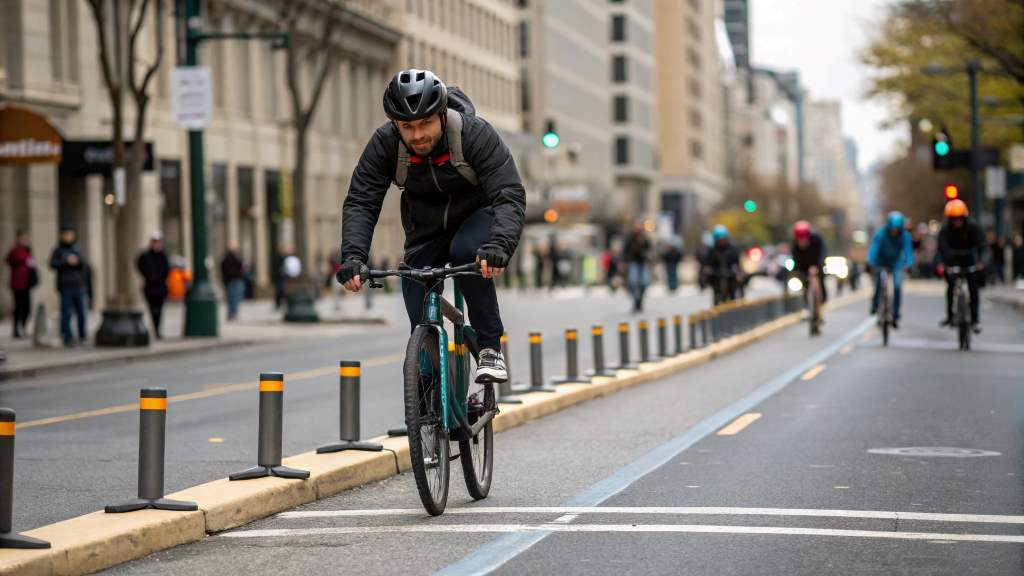Urban biking is exhilarating, but mastering balance is essential for safety and confidence. Whether you’re navigating traffic, riding on uneven terrain, or making sharp turns, balance drills can dramatically improve your riding skills. This guide covers beginner balance point drills for urban biking, helping you build the foundational skills needed to ride with ease in city environments.
Why Balance is Crucial for Urban Biking
Balance is the key to controlled biking. In an urban setting, you face constant stops, turns, and obstacles. A strong sense of balance helps you maneuver confidently through intersections, avoid sudden hazards, and ride smoothly on narrow bike lanes. Without good balance, even experienced riders can struggle in unpredictable city environments.
The Science Behind Balance on a Bike
Balance on a bike involves three main factors:
- Center of Gravity – Keeping your weight distributed properly to avoid tipping over.
- Gyroscopic Effect – The spinning wheels help maintain balance, but stopping or slowing affects this stability.
- Body Coordination – Your ability to shift weight and make micro-adjustments as you ride.
Understanding these elements will help you fine-tune your balance drills.

Beginner Balance Point Drills for Urban Biking
These drills will help you improve stability, control, and confidence on your bike. Practice in a safe, open area before applying them in real traffic situations.
1. The Static Balance Drill (Track Stand)
Why it’s Important:
Track stands help you maintain balance while stopped at traffic lights or in slow-moving traffic.
How to Do It:
- Find a flat, smooth surface.
- Stop your bike completely and keep your feet on the pedals.
- Turn your front wheel slightly left and right while making micro-adjustments to balance.
- Use your core and arms to stabilize yourself.
- Start with a few seconds and gradually increase your time.
💡 Pro Tip: If you lose balance, release the brake slightly and allow the bike to roll forward gently.
2. Slow Speed Control Drill
Why it’s Important:
Urban biking often requires slow-speed maneuvering in crowded areas.
How to Do It:
- Ride at a walking pace in a straight line.
- Keep a relaxed grip on the handlebars.
- Use small, controlled handlebar movements to maintain balance.
- Try riding as slowly as possible without putting your feet down.
💡 Pro Tip: Look ahead, not down at your front wheel. Your body will naturally follow your vision.
3. One-Leg Pedal Drill
Why it’s Important:
Improves balance and coordination by forcing you to rely on core stability.
How to Do It:
- Find a safe, open area.
- Remove one foot from the pedal and rest it on the frame.
- Pedal with the other foot while maintaining balance.
- Switch legs after a few rounds.
💡 Pro Tip: Engage your core and use your arms for small balance corrections.
4. Figure-Eight Drill
Why it’s Important:
Enhances turning control and balance when navigating tight urban spaces.
How to Do It:
- Set up two markers (cones, bottles, or chalk lines) about 10 feet apart.
- Ride around them in a figure-eight pattern.
- Focus on smooth, controlled turns using your body weight.
- Gradually tighten the turning radius as you improve.
💡 Pro Tip: Lean into turns instead of oversteering with your handlebars.
5. No-Hand Balance Drill
Why it’s Important:
Develops better control of the bike using body weight rather than just the handlebars.
How to Do It:
- Start at a comfortable speed.
- Lightly lift your hands off the handlebars while keeping them close.
- Use subtle shifts in your hips and legs to steer the bike.
- Slowly increase the time you can ride without hands.
💡 Pro Tip: Try this on a gentle slope where pedaling isn’t required.
How to Apply These Drills in Urban Riding

Now that you’ve practiced balance drills, it’s time to apply them in real-world settings:
- At Stoplights: Use the Track Stand Drill to avoid frequent foot placement.
- In Crowds: Apply the Slow Speed Control Drill when biking in pedestrian-heavy areas.
- Turning Tight Corners: Use the Figure-Eight Drill to navigate intersections.
- Commuting Comfortably: The No-Hand Balance Drill helps reduce fatigue on long rides.
Common Mistakes and How to Fix Them
Mistakes happen when learning balance drills. Here’s how to correct them:
| Mistake | Correction |
|---|---|
| Gripping handlebars too tightly | Keep a relaxed grip to allow natural bike movements. |
| Looking down | Focus ahead to maintain direction and stability. |
| Losing balance frequently | Start with a wider stance and work on core strength. |
| Overcorrecting steering | Make small, smooth adjustments instead of jerky movements. |
Essential Gear for Better Balance
Investing in the right gear improves safety and performance:
- Flat Pedals: Provide better control when practicing drills.
- Properly Fitted Helmet: Protects you in case of falls.
- Bike Gloves: Help with grip and reduce fatigue.
- Appropriate Tires: Wider tires offer better stability on urban surfaces.
FAQs
How long does it take to improve balance for urban biking?
Most riders see improvement within 2–4 weeks with regular practice.
Can I practice these drills on any bike?
Yes, but a commuter or hybrid bike is ideal for urban settings.
What if I keep losing balance?
Start with a wider stance and focus on engaging your core muscles.
Is it necessary to learn the track stand?
While not mandatory, it greatly enhances control and confidence at stoplights.
Are balance drills useful for long-distance biking?
Absolutely! A strong sense of balance reduces fatigue and improves efficiency on longer rides.
Final Thoughts
Mastering beginner balance point drills for urban biking is essential for safe and confident riding. These drills build core strength, enhance maneuverability, and help you navigate city traffic with ease. Start practicing today, and soon you’ll ride like a pro in any urban environment!

